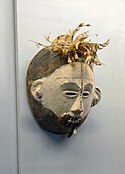Ngbaka
| Populacja | 2,1 mln (2018)[1] |
|---|---|
| Miejsce zamieszkania | Demokratyczna Republika Konga 1793 tys. |
| Język | ngbaka |
| Religia | chrześcijaństwo (95%), religie plemienne |
| Pokrewne | Mumuye, Banda |
Ngbaka, zwani także Mbaka – lud afrykański zamieszkujący północną Demokratyczną Republikę Konga, Kongo i Republikę Środkowoafrykańską. Posługują się językiem ngbaka, należącym do grupy języków ubangi. Ich populację szacuje się na ponad 2,1 mln.
Kultura
Ngbaka słyną ze swoich tradycyjnych masek. Maski w tej społeczności używane są najczęściej podczas obrzędów inicjacji ganza. Twarze są owalne, wklęsłe, z wydłużonym trójkątnym nosem i wyżłobieniami na czole lub skroniach. Często pokryte kaolinem[2].
- (c) Brooklyn Museum, CC BY 3.0
- (c) Brooklyn Museum, CC BY 3.0
Przypisy
- ↑ People Cluster: Adamawa-Ubangi. Joshua Project. [dostęp 2018-08-26].
- ↑ Avner Shakarov, Lyubov Senatorova, Traditional African Art: An Illustrated Study, McFarland, 7 stycznia 2016, ISBN 978-1-4766-2003-9 [dostęp 2018-08-26] (ang.).
Media użyte na tej stronie
Autor: Jean-Pierre Dalbéra from Paris, France, Licencja: CC BY 2.0
Masque facial Ngbaka République démocratique du Congo bois, pigments polychromes, cauris Collection particulière, Belgique
Exposition Fleuve Congo Musée du quai Branly
www.quaibranly.fr/fr/programmation/expositions/a-l-affich...(c) Brooklyn Museum, CC BY 3.0
Although little information exists concerning the masking traditions of the many ethnic groups of the Ubangi region in the northern part of the Democratic Republic of the Congo, masks were likely used during the activities which surrounded boys' initiations and circumcisions. Masks from the region can be identified by their characteristics scarification marks: rows of bumps or incisions running across the forehead and down the bridge of the nose, sometimes extending to the chin.
Autor: Ji-Elle, Licencja: CC BY-SA 3.0
Ngbaka (RDC) : masque. Musée royal de l'Afrique centrale







